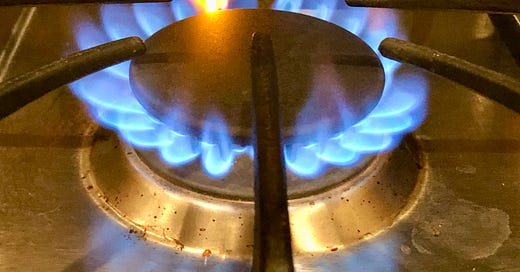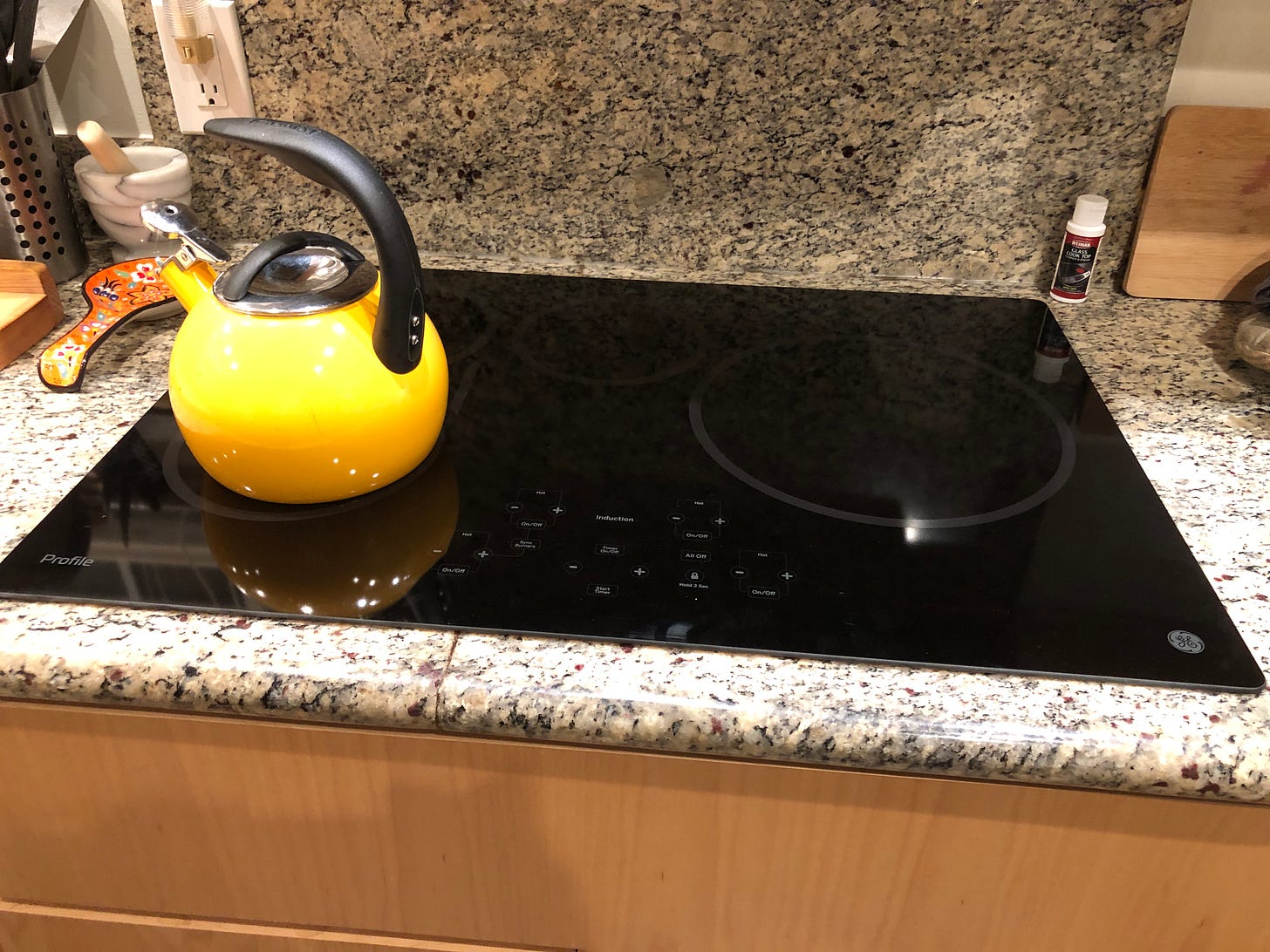During a lunch outing back when I worked at Adobe, the conversation converged on food and current news. At the time, the federal government was considering expanding labels to help consumers better identify the ingredients in the foods we buy.
One of our co-workers wasn’t having any of it. I’ll call him Bob — not his actual name — on the off, off chance that he ever reads this. “I don’t want the government telling me what to eat!” Bob exclaimed.
The rest of us rolled our eyes. When it came to Bob, we were used to rolling our eyes. Bob was a smart, well-educated technical writer — how could he not realize that labeling foods would give consumers more choice, not less?
But Bob was a conservative. Conservatives are terrified of the government taking stuff away from them.
No, they’re not taking away your stove — but should they?
The latest is gas stoves. “The federal government has no business telling American families how to cook their dinner,” tweeted one not-to-be named conservative so-called Democratic senator. It was Bob all over again.
As it turned out, despite a hint in Bloomberg that got everyone in a frenzy, no one was planning to take gas stoves away from the American people.
But it’s true that many cities, and even some states, are trying to accelerate electrification by banning gas in new construction. (They may call it “natural gas,” but “fossil gas” is a better term; there’s nothing natural about what we’re doing with it.)
Why is this important? Because to fight climate change, we need to 1) switch to clean energy and 2) electrify everything. As David Roberts puts it, clean electrification is the non-negotiable climate action “entrée”; everything else is a side dish.
While gas stoves are a small part of this, they may be the “plastic straws” of building emissions, according to Emily Atkin of Heated. By that, she means a small but simple, tangible thing that gets people thinking about the larger issue — in this case, the methane leaks caused by our use of gas. Reducing methane emissions would get a big bang for the climate-change-fighting buck. It takes only a decade for these emissions to dissipate, compared to hundreds or thousands of years for CO2 — which makes reducing methane emissions the quickest way to fight climate change.
Also: Gas stoves are a small component of electrification, but they’re a big contributor to indoor air pollution:
Indoor air can be two to five times more polluted than outdoor air, due in large part to gas stoves.
Gas stoves increase the risk of childhood asthma by 42%.
Indoor air pollution caused by gas stoves is so severe, it turns out, that it would be illegal under current air quality standards for outdoor air. Gas stoves spew carbon monoxide, nitrogen oxides, particulate matter, and formaldehyde into your home. Most range hoods don’t help much, even if people use them — which they usually don’t. Oh, and toxins are leaking into your home even when your stove is off.
Why are we “cooking with gas”?
Given all this, why are gas stoves so popular? People love fire. Good alternatives have only recently become available. But there’s more to it. As usual, we need to follow the money.
You’ve probably heard people say they’re “cooking with gas” in all kinds of contexts. You may have even said it yourself.
But the phrase didn’t emerge organically. Back in the 1930s, an executive at the American Gas Association came up with the slogan “Now you’re cooking with gas” in an attempt to beat the electric stove competition. The expression caught on and soon became so ingrained in the culture — with Bob Hope helping to popularize it — that no one remembered it had come from an ad campaign.
Since then, the gas industry has expanded on its campaigns with tactics like planting pro-gas-stove “neighbors” on Nextdoor, threatening a protest with no social distancing during the height of the pandemic, and paying Instagram influencers to promote #cookingwithgas.

What’s the alternative?
My junior high sex ed teacher, Mrs. Stergultz — who doubled as the prototypical sadistic PE teacher — actually told us that girls are like electric stoves and boys are like gas stoves (I’ll let you figure out why). It was clear that even she could hardly believe she’d said that. We didn’t mind, as her proclamation provided joke fodder for at least the rest of the year. I hadn’t thought much about stoves before then. At some point, though, like most of us, I learned that gas was better than electric.
Nearly 40% of Americans use gas stoves. Until recently, those of us who used them tended to pity those who didn’t. And the truth is that there weren’t good alternatives.
Enter the induction stove. The technology has been popular for some time in Europe and Asia but has only recently become a thing in the U.S.
Powered by electricity and driven by magnetism, induction stoves heat up more quickly and allow much greater temperature control than gas stoves. They’re safer in terms of both burn risk and pollution. Chefs appreciate their precision and responsiveness, and the fact that they don’t heat up the kitchen.
Why aren’t people making the switch?
But people love their gas stoves — progressives as well as conservatives. Whether it’s due to the gas industry’s relentless advertising or to their superiority to traditional electric options, gas stoves enjoy a special place in people’s hearts.
Add to that the obstacles to switching to induction, and you have a tough nut to crack:
How can you cook during a power outage? A few Novembers ago my family in Marin, which includes two elderly parents, endured a four-day power outage. They had to come to our house in Oakland to warm up and charge their phones and laptops, but my sister, a cooking teacher and personal chef, could still cook on her gas stove. In a country with a fragile power grid, we need to address people’s very real concern about relying on electricity for cooking.
Induction stoves aren’t cheap. Buying a new appliance is never cheap, and induction stoves are still more expensive than their gas counterparts. You might also need to buy new pans; only pans that magnets stick to work with induction.
Renters and others face additional barriers. The push to electrify everything raises equity issues. Renters may not be able to replace their stoves, and lower-income families may not be able to afford replacements. About 14% of households on Native lands don’t even have access to electricity.
What can you do?
While we’ll all eventually (and by eventually, I mean soon) have to partake of the clean electrification entrée, you can start by breaking it into smaller bites.
Rafael and I are down with electrification, but because of the high costs, our electrification journey has been slow. It took us till last summer to finally buy a used EV. Heat pumps are still just out of reach (but will soon be much more attainable!). An induction cooktop, in contrast, felt like a doable step on our path to electrifying everything.
And there are incentives! Incentives are your friends, and new ones are coming up thanks to the Inflation Reduction Act.
A few tips for making the switch:
Start with a portable induction burner. Some options are listed on page 8 of this guide from Redwood Energy, along with other electrification tips.
Check out federal incentives. This Inflation Reduction Act calculator from Rewiring America lets you see which incentives you might qualify for — for induction stoves and much more. Some hefty ones are coming for income-qualified people, and the income requirements aren’t as low as you might think. More on electrification in the Rewiring America guide.
Check out local incentives. We just applied for a $750 induction cooktop rebate from BayREN, a Bay Area partnership of local governments. Wish us luck!
Wait for new models with built-in batteries. An idea whose time has come! When these become more common and affordable, they’ll provide a great option to get you through power outages.
Vote for Democrats. I’ve said it before, and I’ll say it again: electing Democrats is one of the most effective climate actions you can take, and it affects the incentives you get. Despite that aforementioned senator, the Dems are the ones who brought us the Inflation Reduction Act.
This may not be the time for you to make the switch. We all do what we can when we can. But when the time comes for you, I hope this post has planted the seeds to help you on your way.
Have you thought about making the switch away from gas? Let me know in the comments if you’ve taken any steps or have questions or concerns!









Great column, and your picture is just as adorable as that of the hipster chick!
Many people are afraid that electric stoves don't offer the precision of gas stoves, but I find that our induction stove is even more precise than our gas range was! I love cooking on it.
Love this article, Rosana! I’ve been thinking about getting a single induction burner. Agreed about the equal adorableness of your photo 😆❤️❤️